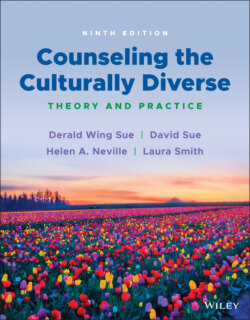Читать книгу Counseling the Culturally Diverse - Laura Smith L. - Страница 69
CHAPTER OBJECTIVES
Оглавление1 Identify the basic values, beliefs, and assumptions that characterize U.S. society, and how these can manifest in counseling practice.
2 Develop an awareness of how taken‐for‐granted, generic characteristics of counseling and psychotherapy may be barriers to culturally diverse clients.
3 Describe how the cultural values and characteristics of diverse populations may affect the counseling process.
4 Understand the relevance of culture‐related communication barriers as pitfalls for counselors, given that verbal communication is the basic vehicle by which counseling and therapy take place.
5 Learn how Western conceptions of the family may detrimentally impact counseling and therapy with diverse families.
6 Understand the linguistic barriers that may arise in working with clients whose first language is not English.
7 Describe how socioeconomic class issues can also create cultural barriers that undermine mental health services.
8 Learn how Western conceptions of the family may detrimentally impact counseling and therapy with diverse families.
Full Counseling Session video (Part I): “Communication Styles and Counseling” (features “Joel” and “Reiko”)
It would be weeks of replaying that conversation (over and over again in my head) before I would pick up the phone and call [the therapist's] office … I told you about me, my struggles and how I was feeling inside. You sat there in your expensive clothing, your perfectly decorated office, and smiled at me the entire time. When I finished being open, vulnerable and raw, you said words that would haunt me to this day: “You seem like a strong Black woman, and found ways to cope. I'm proud of you. Please come back if you feel like life is too much to handle” … Why didn't you hear me? Why didn't you acknowledge the internal battle between me, my culture and my faith that I had to overcome? Why didn't you see all of me? Why did you ignore the tears that streamed down my cheeks? Why didn't you know that I had had enough of being “strong?” (Cooper, 2017, para. 5)
“You're always moderating yourself,” [says] a Latina executive, who feels that Latinas “are always tagged with the emotional thing. They're always told, ‘Calm down. You've got to be more cool. Be careful with your voice, be careful with your hands’.” Hispanic men echo her observations. One ruefully told of moving from a Hispanic‐dominated company, where he could gesture eloquently and speak passionately, to a Caucasian workplace where he had to “scale back” his expressiveness. (Hewlett, Allwood, & Sherbin, 2016)
Asian cultures generally don't have a huge vocabulary for feelings or value them highly in the first place; we simply aren't encouraged to pay attention to them. Thus, many of us have limited awareness of our emotional experiences, let alone words to describe them. On top of that, talking about yourself is generally viewed as immodest in Asian cultures, which place a high premium on modesty. Through that lens, making regular appointments to talk about yourself seems self‐indulgent at worst and uncomfortable at best. The hurdles don't end there. Asian cultures tend to be vastly different than the Western ones from which most therapists, and the process of therapy itself, originated. In some regards, such as the emphasis on the individual vs. the group, the cultures are diametrically opposed. Thus, there's often a fear that cultural issues will be misunderstood or pathologized in therapy. (These fears are not unwarranted; the field has an embarrassing history of misinterpreting cultural nuances as personal shortcomings.) (Lin, 2014, para. 32)
